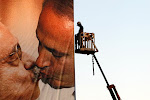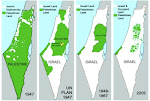Archaeology Buzz: King Solomon's hives

Scientists from Hebrew U are all abuzz with evidence that Israel lived up to its Biblical moniker of the land of "milk and honey"-- well, at least the latter. Ancient beekeepers kept their hives in the middle of Tel Rehov town in the 10th century BCE, the era of Solomon's First Temple.
Their unbaked clay and straw hives resemble the stacked cylinders shown in Egyptian Pharaonic art. These were used on an industrial scale, producing up to half a ton of honey a year, according to Professor Amihai Mazar, and are the first to be unearthed anywhere in the Near East. The ritual use of honey over the ages will be examined by scholars who know their beeswax. What a sweet discovery-- in good time for the Jewish New Year, when slices of apple are dipped in honey at every Seder dinner. Check out the report in the latest Science Daily journal:
The ritual use of honey over the ages will be examined by scholars who know their beeswax. What a sweet discovery-- in good time for the Jewish New Year, when slices of apple are dipped in honey at every Seder dinner. Check out the report in the latest Science Daily journal:
The term "honey" appears 55 times in the Bible, 16 of which as part of the image of Israel as "the land of milk and honey". It is commonly believed that the term refers to honey produced from fruits such as dates and figs. Bees' honey, on the other hand, is mentioned explicitly only twice, both related to wild bees. The first instance is how Samson culled bees' honey from inside the corpse of the lion in the Soreq Valley (Judges 14: 8-9). The second case is the story of Jonathan, King Saul's son, who dipped his hand into a honeycomb during the battle of Mikhmash (Samuel I 14:27).
While the Bible tells us nothing about beekeeping in Israel at that time, the discovery of the apiary at Tel Rehov indicates that beekeeping and the extraction of bees' honey and honeycomb was a highly developed industry as early as the First Temple period. Thus, it is possible that the term "honey" in the Bible indeed pertains to bees' honey.
Cultic objects were also found in the apiary, including a four-horned altar adorned with figures of naked fertility goddesses, as well as an elaborately painted chalice. This could be evidence of deviant cultic practices by the ancient Israelites related to the production of honey and beeswax.
NMSHAn intriguing inscription on a ceramic storage jar found near the beehives reads "To nmsh". This same name was also inscribed on another storage jar from a slightly later occupation level at Tel Rehov, dated to the time of the Omride Dynasty in the 9th century BCE. Moreover, this same name was found on a contemporary jar from nearby Tel Amal, situated in the Gan HaShelosha National Park (Sachne).
The name "Nimshi" is known in the Bible as the name of the father and in several verses the grandfather of Israelite King Jehu, the founder of the dynasty that usurped power from the Omrides (II Kings: 9-12). It is possible that the discovery of three inscriptions bearing this name in the same region and dating to the same period indicates that Jehu's family originated from the Beth Shean Valley and possibly even from the large city located at Tel Rehov. The large apiary discovered at the site might have belonged to this illustrious local clan.




















1 comment:
I read this story on CNN and immediately thought of Izzy Bee :)
Post a Comment